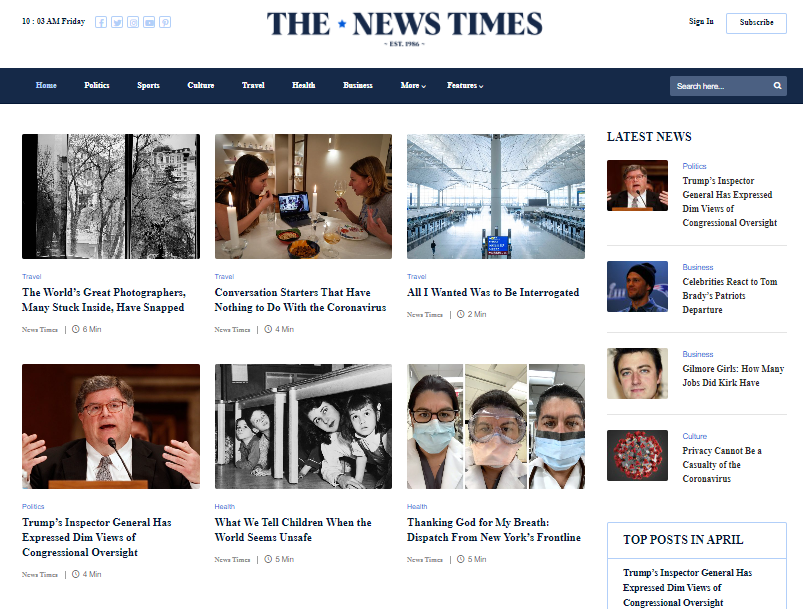The Effect of Social Media en route We Eat News Online
Social network has basically transformed news usage. It supplies immediate access to info, usually overshadowing traditional media electrical outlets. This rapid dissemination comes with obstacles. Individuals deal with the danger of coming across misinformation and ending up being trapped in echo chambers. The formulas driving customized content can cover diverse perspectives. As these characteristics progress, comprehending their implications becomes essential for educated interaction in public discourse. What strategies might aid navigate this facility landscape?
The Evolution of News Consumption in the Digital Age
As innovation progressed, the means individuals eaten news changed considerably in the electronic age (stnews.live). Typical papers and transmitted media began to decrease as the internet arised as a key source of details. On the internet platforms provided instantaneous access to newspaper article, videos, and podcasts, enabling users to stay notified at any type of time. The ease of smart phones even more increased this shift, making it possible for users to obtain updates on the go
Additionally, the increase of news collectors and websites promoted the consumption of diverse viewpoints, encouraging customers to customize their news intake based upon personal rate of interests. This development likewise triggered news organizations to adapt their strategies, concentrating on electronic content and engaging visitors with multimedia layouts. Therefore, the standard obstacles of time and space in news shipment lessened, leading to a much more immediate and individualized news experience for audiences worldwide.
The Role of Social Media Operatings Systems in News Circulation
Social network systems have actually transformed news distribution by supplying instantaneous accessibility to details. Their algorithm-driven content curation frequently focuses on involvement over precision, bring about substantial reliability difficulties (stnews.live). As users navigate this landscape, the ramifications for news usage and public discourse ended up being progressively complicated
Instant News Access
Conventional news outlets have long been the key resource of info, the rise of social media platforms has significantly changed just how news is accessed and taken in. Instant news accessibility has actually come to be a trademark of the digital age, enabling individuals to receive updates in actual time. Systems such as Twitter, Facebook, and Instagram allow news to spread out swiftly, often surpassing traditional media in rate and reach. Individuals can share stories, discuss events, and engage with journalists, creating a vibrant communication between the target market and news content. This immediacy cultivates a culture of urgency, motivating users to inquire promptly. As a result, the assumption for timely news has actually improved journalistic methods, engaging news organizations to adjust their methods to meet the needs of a busy digital setting.
Algorithm-Driven Content
While individuals actively involve with content on social media, the algorithms that regulate these systems play a critical duty in identifying which news tales acquire presence. These formulas evaluate individual behavior, preferences, and engagement metrics to curate customized news feeds. Consequently, certain tales might be intensified while others remain rare, typically focusing on spectacular or trending subjects over substantive coverage. This careful exposure shapes customers' understandings of existing occasions and affects public discourse. The dependence on algorithm-driven content can create echo chambers, where customers are mostly exposed to perspectives that straighten with their own beliefs. The characteristics of news distribution on social media platforms significantly influence exactly how people take in and analyze info in the electronic age.
Credibility Challenges
As customers progressively turn to social media for news, the trustworthiness of information encountered on these platforms ends up being a pressing concern. The decentralized nature of social media sites enables anybody to release content, often obscuring the lines in between trustworthy journalism and misinformation. Algorithms focus on engagement over accuracy, resulting in the extensive circulation of sensational or deceptive stories. This atmosphere positions substantial challenges for users attempting to discern trustworthy sources. Social network platforms, while striving to fight misinformation through fact-checking and material small amounts, face objection for inconsistencies and biases in their methods. Ultimately, the obligation exists with individuals to critically evaluate the news they take in, as the quick spread of information often outmatches confirmation initiatives by systems.
The Rise of Citizen Journalism and User-Generated Material
The increase of citizen journalism has actually empowered everyday individuals to share news and point of views, usually providing insights that conventional media may overlook. Nevertheless, this shift likewise provides considerable difficulties, especially the spread of misinformation that can develop from unproven material. As user-generated web content comes to be extra prevalent, the balance in between genuine voices and precision in reporting stays an essential issue.
Empowering Everyday Voices

Challenges of Misinformation
While the increase of resident journalism has actually opened up methods for varied voices in the media landscape, it has actually likewise introduced significant challenges connected to misinformation. The simplicity of sharing details with social media sites platforms permits people to disseminate news swiftly, but this quick spread frequently comes with the cost of accuracy. User-generated content regularly does not have the extensive fact-checking and content oversight that standard journalism gives. Subsequently, sensationalized or incorrect narratives can gain grip, misguiding audiences and forming public perception (stnews.live). Additionally, the blending of viewpoint and truth within social media sites makes complex the difference between reputable details and false information. Because of this, customers should browse an increasingly complicated media setting, calling for essential thinking skills to recognize reputable news resources amidst the sound

False information and Its Implications for Public Discussion
As social networks systems increasingly dominate the landscape of this page information dissemination, the proliferation of misinformation presents substantial challenges for public discussion. False information, typically created to misdirect or provoke psychological reactions, can misshape perceptions of fact and undermine rely on legitimate sources. This sensation leads to polarized perspectives, as people gravitate towards resemble chambers that strengthen their ideas, further entrenching divisions within society.
The ramifications for public discussion are extensive. When citizens count on incorrect information, meaningful dialogue lessens, and the autonomous procedure endures. In addition, misinformation can provoke fear and confusion, affecting public wellness, safety and security, and political stability. As a result, fostering media literacy comes to be essential, empowering people to seriously examine info and determine fact from fiction. Dealing with the difficulties positioned by misinformation is vital for protecting the stability of public discourse and ensuring a well-informed populace efficient in taking part in positive discussions.
The Influence of Formulas on News Exposure
Provided the main function of formulas in determining material presence, their influence on news intake is extensive. These algorithms, made use of by social media systems, prioritize certain kinds of web content based upon individual interaction and preferences. Consequently, news short articles that straighten with preferred fads or audience rate of interests are most likely to be presented plainly, while less sensational stories might be ignored. This creates a setting where individuals are revealed mainly to details that strengthens their point of views, potentially leading to echo chambers.
Moreover, the continuous advancement of algorithms means that wire service need to adapt their strategies to straighten with these changing criteria, typically focusing on clickbait or mentally billed headlines. Consequently, the honesty of news reporting can be jeopardized, as critical stories might not obtain the exposure they are entitled to. The algorithmic shaping of news visibility consequently plays an essential role in influencing public perception and understanding of current events.
The Shift Towards Visual Narration in News Media
Progressively, news media is check out this site embracing visual narration as an effective device to involve target markets. This approach leverages pictures, videos, infographics, and interactive elements to convey information much more properly than standard text-based layouts. As focus covers reduce, visuals use a quick, impactful way to communicate intricate tales and get hold of customers' rate of interest.
Systems like Instagram and TikTok have additional accelerated this fad, engaging news organizations to adapt their content approaches to fit these visually-driven settings. By incorporating engaging visuals, news electrical outlets can improve psychological links and foster higher understanding of topical issues.
Moreover, aesthetic narration enables even more varied narratives, showcasing several viewpoints with vibrant presentations. As target markets significantly eat news with mobile devices, the change towards visuals not only accommodates customer choices however additionally helps to damage down barriers to details accessibility. Inevitably, this development reflects a more comprehensive transformation in just how news is created and eaten in the digital age.
Future Trends: Browsing the Altering Landscape of News Consumption
While the electronic landscape continues to advance, news usage is poised for substantial improvement driven by emerging technologies and altering audience habits. As artificial knowledge and machine understanding advance, personalized news feeds will certainly come to be extra widespread, enabling customers to obtain material tailored to their interests. This customization could cause better engagement yet additionally increase concerns concerning echo chambers and misinformation.
The increase of voice-activated tools and clever audio speakers will certainly affect how news is supplied, moving the focus from visual to auditory formats. This pattern may urge news organizations to embrace even more concise and interesting audio material.

Often Asked Questions
Just How Do Social Media Communications Affect News Credibility?
Social media communications can considerably influence perceptions of news credibility. Involvement metrics, such as likes and shares, typically shape target market depend on, with prominent posts obtaining viewed legitimacy, no matter the precision or reliability of the information useful link offered.
What Function Do Influencers Play in Shaping News Narratives?
Influencers significantly form news narratives by leveraging their platforms to amplify specific stories, often customizing web content to their audience. This can bring about biased viewpoints, influencing public assumption and focusing on sensationalism over factual reporting.
Just How Can Users Identify Reliable News Sources on Social Media?
Users can identify trustworthy news resources on social media sites by examining the resource's credibility, confirming facts through numerous electrical outlets, examining the professionalism of the material, and recognizing prospective prejudices in reporting to guarantee precise info.
What Impact Does Social Network Carry Traditional Journalism Jobs?
Social network substantially affects standard journalism work by altering income designs, lowering demand for print media, and fostering competition from resident reporters. Subsequently, lots of specialists deal with work insecurity and must adapt to quickly altering media landscapes.
Just How Do Different Demographics Consume News on Social Media?
Different demographics exhibit diverse preferences for news consumption on social media sites. More youthful audiences favor platforms like TikTok and Instagram for quick updates, while older people often tend to choose Facebook and Twitter for a lot more comprehensive conversations and short articles.